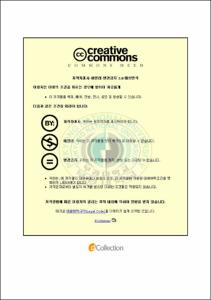서모트로픽 主鎖型 高分子液晶의 相轉移 現象과 誘電特性
- Alternative Title
- Phase transition and dielectric properties of a thermotropic main-chain type liquid crystalline polymer
- Abstract
- LCD(LCD: Liquid Crystal Display)의 응용은 TV표시로 대표되는 민생분야로부터 컴퓨터 단말표시 등의 정보산업 분야까지 다양한 분야에 걸쳐 있다. 이뿐만 아니라 액정은, 전자 샷터나 광변조기 등의 포토일렉트로닉스 디바이스, 온도·전계센서 등의 계측용도로서도 그 응용전개가 활발히 진행되고 있다. 또한 고분자액정은 고강도, 고탄성 등을 특징으로 하는 고기능성 물질로서 뿐만 아니라 기록매체나 메모리소자와 같은 고기능성 고분자 재료로서도 그 활용이 기대되고 있다. 서모트로픽(thermotropic) 고분자액정은 지난 수년에 걸쳐 많은 주목을 받고 있다[1]. 이 물질은 서모플라스틱 수지와의 브랜드 물질내에 있어서 메트릭스의 보강성에 따라 좋은 가공조건과 탁월한 역학적 특성을 제공한다.
이러한 서모트로픽 고분자액정에 관한 산업 및 학술적 연구는 기술적 장점의 적당한 특성을 가진 적절한 화학구조를 만들기 위하여 구조적 특성관계를 이해하는데 그 초점을 두고 있다[2].
유전완화 특성에 관한 조사는 분자운동이 중간상(mesomorphic)구조에 필수적 역할을 하므로[2~5] 구조적 특성관계 연구에 필수적이다. 그러나 주쇄형 고분자액정은 종종 매우 복잡한 특성을 나타내기 때문에 그 자세한 연구는 몇 가지 경우에 국한되어 있다[3~12]. 특히 이 물질에 있어서 저온 전이는 화학적 구조 및 열처리에 강하게 의존한다. 유전 스펙트로스코피(spectroscopy)는 분자의 동특성을 조사하기 위한 강력한 기법이며[2], 특히 고분자액정의 경우는 더욱 그러하다[3, 5, 7, 9].
유전분석은 동적 역학분석에 비해 더욱 넓은 주파수범위에 걸쳐 수행할 수 있으므로 동적 역학분석 연구에 대한 보충적 정보를 제공한다. 주쇄형 고분자액정의 유전분석에 대한 대부분의 보고는 강직뿐만 아니라 반강직 폴리에스테르와 관련된다.
이러한 유전분석에 의하면 이 물질에서의 완화과정은 2가지의 형식으로 이행된다. 그 하나는 글라스전이와 관련된 완화이며 다른 하나는 방향성 링의 양변에 붙어있는 에스테르기의 국부적 운동에 의한 완화이다[2~12]. 이러한 유전분석은 대부분 유전온도분산측정에 의한 것이며 더욱 자세한 분석을 위해서는 넓은 주파수범위의 주파수분산 측정결과가 필요하다.
본 연구에서는 서모트로픽 고분자액정인 BB-3(1-methyl)의 분자운동에 의한 상전이현상을 규명하는 것이 그 목적이다. 이를 위하여 온도변화에 따른 이 물질의 상태를 편광현미경을 통하여 관찰하였으며 유전온도분산 측정결과와 유전주파수분산 측정결과를 토대로 상전이현상을 분석하였다.
In this study phase formations in thermotropic main-chain type liuid crystal polymer along to temperature were observed through the optical microscopic observation.As a result it was found that glass transitions of liquid crystal glass sample and liquid glass sample were different each other.For more detailed analyzing of these different transitions temperature and frequency dielecctric dispersions were measured and the data were analyzed using curve fitting method.The results are follows.
<1> Optical microscopic observation
(1) In the glass transition of liquid crystal glass sample, frozen liquid crystal molecules become gradually flexible with the increase of temperature and then take liquid crystalline phase at Tg(glass transition temperature), while in liquid glass sample, it seems that isotropic amorphous phase performs very fast the transition to liquid crystalline phase at Tg.
(2) Phase transition to amorphous phase from liquid crystalline phase are initiated at 148℃ and completed above 150℃ in not only liquid crystalline glass sample but also liquid glass sample.
(3) In whole range of experimental temperature dielectric constants of liquid glass sample are larger than that of liquid crystalline glass sample. It seems that intramolecular binding force for spacer in liquid glass sample is larger than that in liquid crystalline glass sample.
(4) Above 150℃ real part of dielectric constant was decreased rapidly. It means that the transition to amorphous phase from liquid crystalline phase appears at above 150℃.
<2> Dilelectric experiments
(1) Temperature dielectric dispersion
1) While increasing temperature real part of dielectric constant starts to increase at about 70℃ in liquid crystalline glass sample and at about 92℃ in liquid glass sample. These facts mean that above temperatures are Tgs in both samples.
2) The increase fo the real part is completed at about 105℃ and the real part shows saturation value as maximum value above 105℃ in each sample. These means that the glass transitions in both samples are completed at the same temperature 105℃.
(2) Frequency dielectric dispersion
1) Dielectric strength △ε showed about 3 above 86℃ liquid crystalline glass sample and about 4.9 above 90℃ in liquid glass sample.
2) Below 88℃ relaxation frequency fm in liquid sample is much lower than that in liquid crystalline glass sample. This means that fm depend largely on main-chain motion rather than local motion of intramolecular spacer.
3) Parameter β increases with the increase of temperature and β in liquid glass sample is larger than that in liquid crystalline glass sample. This fact means that β depends on not only interaction between molecules but also intramolecular binding force for spacer.
- Issued Date
- 2008
- Awarded Date
- 2008. 8
- Type
- Dissertation
- Publisher
- 부경대학교 산업대학원
- Alternative Author(s)
- Lee, Jae-Hoon
- Affiliation
- 부경대학교 산업대학원
- Department
- 산업대학원 전기공학과
- Advisor
- 강대하
- Table Of Contents
- 표 목차 = ⅲ
그림 목차 = ⅳ
Abstract = ⅵ
제1장 서론 = 1
제2장 유전이론 = 3
2.1 분극 = 3
2.1.1 전자분극과 원자분극 = 3
2.1.2 쌍극자분극 = 4
2.1.3 전극분극 = 5
2.2 유도분극과 배향분극 = 5
2.2.1 유도분극 = 6
2.2.2 배향분극 = 7
2.3 유전율 = 9
2.4 유전완화 = 11
제3장 액정 = 16
3.1 액정의 분자구조 = 16
3.2 액정 디바이스의 응용 = 19
3.3 액정의 강유전효과 = 22
3.4 고분자 액정 = 26
제4장 주쇄형 서모트로픽 고분자액정 BB-3(1-methyl)의 유전특성 = 28
4.1 BB-n 폴리에스테르 = 28
4.2 측정시료의 분자구조 및 각 상의 현미경 관측 형상 = 29
4.3 측정시료 셀 및 측정방법 = 36
4.4 측정결과 및 검토 = 37
제5장 결론 = 52
[참고문헌] = 55
- Degree
- Master
- Files in This Item:
-
-
Download
 서모트로픽 主鎖型 高分子液晶의 相轉移 現象과 誘電特性.pdf
기타 데이터 / 1.49 MB / Adobe PDF
서모트로픽 主鎖型 高分子液晶의 相轉移 現象과 誘電特性.pdf
기타 데이터 / 1.49 MB / Adobe PDF
-
Items in Repository are protected by copyright, with all rights reserved, unless otherwise indicated.